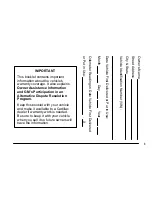
2
47
TPMS – Tire Pressure
Monitoring System
The vehicle is equipped with a system
that monitors the tire pressure by
means of special sensors fitted inside
the wheel rims, in position with
the inflation valve. These sensors
transmit a signal that is detected by
the antennas installed on the vehicle
body, behind the gravel guards and
connected to the ECU.
WARNING: The system can
momentarily experience radio-electric
interference emitted by devices using
similar frequencies.
The ECU processes this information
and, via the CAN line, transmits a
series of tire pressure data and system
errors, if any, to the instrument panel.
The display may show the information
received by means of specific screen
pages, which can be recalled selecting
the “Tire Pressure” page.
The system warns the driver
that the tire pressure has
decreased. This warning
does not exempt the driver from
periodically checking the tires and
from complying with the prescribed
tire pressure levels.
WARNING: The system stores the
tire pressures as a reference rate,
therefore tires must be inflated to the
prescribed pressure.
Each tire, including the spare one
(if provided), should be checked
monthly when cold and inflated to
the inflation pressure recommended
by the vehicle manufacturer on
the vehicle placard or tire inflation
pressure label. (If your vehicle has tires
of a different size than that indicated
on the vehicle placard or tire inflation
pressure label, you should determine
the proper tire inflation pressure for
those tires.)
As an added safety feature, your
vehicle has been equipped with a tire
pressure monitoring system (TPMS) that
illuminates a low tire pressure warning
light when one or more of your tires
is/are significantly under-inflated.
Accordingly, when the low tire
pressure warning light illuminates,
you should stop and check your tires
as soon as possible, and inflate them
to the proper pressure.
Driving on a significantly under-inflated
tire causes the tire to overheat and can
lead to tire failure. Under-inflation also
reduces fuel efficiency and tire tread
life, and may affect vehicle handling
and stopping ability.
Please note that the TPMS is
not a substitute for proper tire
maintenance, and it is the driver’s
responsibility to maintain a correct
tire pressure, even if under-inflation
has not reached the level to trigger
illumination of the TPMS low tire
pressure warning light.
Your vehicle has also been equipped
with a TPMS malfunction indicator
that indicates when the system is not
operating properly.
The TPMS malfunction indicator is
combined with the low tire pressure
warning light.
When the system detects a
malfunction, the warning light will
flash for approximately one minute
and then remain permanently
illuminated.
This sequence will continue upon
subsequent vehicle start-ups as long
as the malfunction persists.
When the malfunction indicator
is illuminated, the system may not
be able to detect or signal low tire
pressure as intended.
TPMS malfunctions may occur for
a variety of reasons, including
the installation of replacement or
alternate tires or wheels on the
Summary of Contents for GranTurismo Sport 2015
Page 1: ...2015 Owner s Manual...
Page 3: ...3...
Page 6: ...6 3500 GT Mistral coup Ghibli coup...
Page 14: ...14...
Page 17: ...1 17 Homologation labels Safety standard label V I N label Chassis type and number...
Page 18: ...1 18 Emission control data label...
Page 19: ...1 19 Instruction labels Tire speci cation label Lubricant label Mercury content warning label...
Page 20: ...1 20 Anti freeze label...
Page 22: ...22...
Page 36: ...9 2 5 13 8 1 15 16 12 11 10 7 6 3 4 14 2 36 Front and side airbags...
Page 58: ...58...
Page 88: ...88...
Page 119: ...B A 4 119 Controls A Display B Multi Media System controls...
Page 123: ...A A B E F C D D A 4 123 Air conditioning...
Page 231: ...9 231 Table of contents Table of contents 232 Alphabetical contents 236...
















































